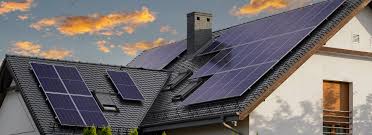It is common these days to see people using solar panels and solar energy in their homes if they want to cut down their electricity costs. Most of the home solar Installer and Pennsylvania home Solar installers are stating high demand for rooftop solar systems. But solar has so much more potential than just being a home power source. Here we look at some of the best and most exciting solar panel applications for commercial, industrial, and public use.
Solar Panels for Electric Vehicle Charging Stations
Electric cars are not as rare as they used to be, as they are currently experiencing a higher demand than they did in the past. However, there is always the concern, commonly known as range anxiety, that the car’s battery will run out while driving. These concerns could be addressed through the creation of even more solar-powered EV charging stations. Integrated design of solar car parks with solar panels as shading devices offer shade to parked cars while charging green electricity to fast charge the EVs. Today, more advanced stations such as those owned by Tesla are being deployed with solar and battery technologies. Local authorities can also bring these solar-powered EV stations through curbside installation on avenues or parking lots to foster more people’s transition to non-emitting vehicles.
Floating Solar Arrays on Lakes and Reservoirs
Another great utilization of space for big solar PV is to use of the concept of floating solar systems on reservoirs and artificial lakes. According to one estimate, if floating solar is installed on only 1% of reservoirs in Southern states, it could generate 10% of the electricity in the region. Floating solar farms have a low environmental footprint while producing maximum power due to the cooling offered by the water below. Some large generators are now developing prototypes, such as a 2.5 MW machine by Ocean Sun in Singapore. In some of the affected regions, it has the added benefit of preventing evaporation where drinking water reservoirs are covered by solar panels.
Agriculture and Greenhouses Running on Solar
Fossil fuels and grid electricity are the most common sources of energy that farmers depend on for the operation of their farms. The cost of Solar Estimation for the systems that can offer clean electricity for food production is also getting cheaper. It can pump water for crops to be irrigated during the day through solar panels. They can also supply power for greenhouses to grow plants and vegetables all year round without the need for fuel used in heating and lighting up the structures. Such solar systems as those of Sundynamic are now being put in farmlands in rural areas that supply food to America’s cities. When integrated with advanced battery storage, greenhouses are even moving closer to cities to offer fresher local produce sourced from solar-powered technologies.
Charging and Connecting Remote Communities
Rural areas, individual buildings, aboriginal settlements, and islands or highland areas are often not connected to a centralized power grid. Solar microgrids with battery storage systems are coming up as viable distributed power solutions. Such off-grid solar systems can seamlessly integrate groups of homes and other public infrastructure with clean, reliable power at the most remote locations. Nonprofit organizations also keep on developing thousands of solar microgrids to power schools and clinics in the rural areas of other countries as well. At home, solar, and battery microgrids can also rejuvenate worn-out expensive overhead power lines in sparsely populated rural areas. Providing remote solar power solutions for everyone creates new social opportunities and contributes to the growth of the economy.
Solar Data Centers and Bitcoin Mining
As electricity demand has grown significantly from data centers and Bitcoin/cryptocurrency mining activities, some innovative miners are now using solar power. Cryptocurrency mining involves a lot of computing power and thus a lot of energy use while solar is a renewable energy source. There exists an opportunity whereby miners can reduce costs, and at the same time, enhance sustainable operations. CleanSpark offers software and solutions for solar microgrids for enterprises involved in Bitcoin mining. Giga Energy Solutions deal in solar power recently signed a deal with a Bitcoin miner to build a 3MW solar plant with battery storage in Texas to make the Bitcoin mining facility renewable and independent in its energy needs. With the future advancement of blockchain technologies, the scaling of solar infrastructures will remain vital for carbon-neutral goals.
Advantages and Disadvantages of Liberalisation of Solar Power
Considering the ability of solar to spur advancements in multiple industries including electric vehicles, agriculture, remote connectivity, computing, and many more, it appears that a massive increase in renewable generating capacity across the country is inevitable. It is still unknown as to how gradual and how swift the solar transition could be. The post-2020 vision offers many advantages in jobs, affordability of new technologies, sustainability, and support for emerging occupations through a higher solar installation worldwide. However, to reap the benefits, policymakers, and industry leaders will have to address integration challenges and grid management issues arising from INTERMITTENT RENEWABLE ENERGY sources when LARGE SCALE SOLAR ENERGY is integrated into volumes close to 50% and above. Standard energy infrastructure and utility company business models may also need significant changes as well.
Conclusion
Industrialization and new financial models for the adoption of solar power are making it even cheaper each year. There are numerous opportunities for utilizing creative solar solutions in transportation, agriculture, and food chains, remote and rural area power, office and data center power, and decentralized power and smart grid technologies that use microgrids. If societies can harness solar power to fuel change across multiple aspects of a given economy, societies will be better prepared to navigate the transition to a 21st-century clean energy economy. However, to get from today’s solar generation levels to the required magnitude will also bring about new technical and social impacts. Finding the right mixture of policies and investments to safely drive this change can light communities for generations ahead. Experience from Texas home solar Installer and Pennsylvania Solar installers nationwide along with federal support for high-impact demonstrations will assist solar to continue to innovate beyond expectations.



